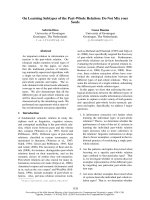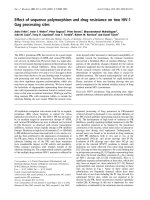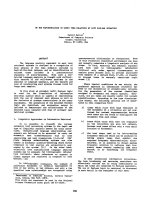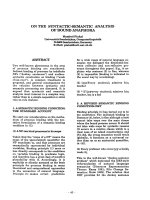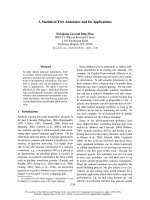Báo cáo khoa học: "ON REPRESENTING GOVERNED PREPOSITIONS AND HANDLING "INCORRECT" AND NOVEL PREPOSITIONS" ppt
Bạn đang xem bản rút gọn của tài liệu. Xem và tải ngay bản đầy đủ của tài liệu tại đây (678.85 KB, 8 trang )
ON REPRESENTING GOVERNED PREPOSITIONS AND
HANDLING "INCORRECT" AND NOVEL PREPOSITIONS
Hatte R. Blejer, Sharon Flank, and Andrew Kchler
SRA Corporation
2000 15th St. North
Arlington, VA 22201, USA
ABSTRACT
NLP systems, in order to be robust,
must handle novel and ill-formed input.
One common type of error involves the use
of non-standard prepositions to mark
arguments. In this paper, we argue that
such errors can be handled in a systematic
fashion, and that a system designed to
handle them offers other advantages. We
offer a classification scheme for
preposition usage errors. Further, we show
how the knowledge representation
employed in the SRA NLP system
facilitates handling these data.
1.0 INTRODUCTION
It is well known that NLP systems,
in order to be robust, must handle ill-
formed input. One common type of error
involves the use of non-standard
prepositions to mark arguments. In this
paper, we argue that such errors can be
handled in a systematic fashion, and that a
system designed to handle them offers
other advantages.
The examples of non-standard
prepositions we present in the paper are
taken from colloquial language, both
written and oral. The type of error these
examples represent is quite frequent in
colloquial written language. The frequency
of such examples rises sharply in evolving
sub-languages and in oral colloquial
language. In developing an NLP system to
be used by various U.S. government
customers, we have been sensitized to the
need to handle variation and innovation in
preposition usage. Handling this type of
variation or innovation is part of our
overall capability to handle novel
predicates, which arc frequent in sub-
language. Novel predicates created for sub-
languages arc less "stable" in how they mark
arguments (ARGUMENT MAPPING) than
general English "core" predicates which
speakers learn as children. It can be
expected that the eventual advent of
successful speech understanding systems
will further emphasize the need to handle
this and other variation.
The NLP system under development
at SRA incorporates a Natural Language
Knowledge Base (NLKB), a major part of
which consists of objects representing
SEMANTIC PREDICATE CLASSES. The
system uses hierarchical knowledge sources;
all general "class-level" characteristics of a
semantic predicate class, including the
number, type, and marking of their
arguments, are put in the NLKB. This
leads to increased efficiency in a number
of system aspects, e.g., the lexicon is more
compact and easier to modify since it only
contains idiosyncratic information. This
representation allows us to distinguish
between Icxically and semantically
determined ARGUIVIENT MAPPING and to
formulate general class-level constraint
relaxation mechanisms.
I.I CLASSIFYING PREPOSITION
USAGE
Preposition usage in English in
positions governed by predicating elements,
whether adjectival, verbal, or nominal, may
be classified as (I) lexically determined, (2)
syntactically determined, or (3)
semantically determined. Examples are:
LEXICALLY DETERMINED:
laugh at, afraid of
SYNTACTICALLY DETERMINED:
by in passive sentences
SEMANTICALLY DETERMINED:
move to~from
Preposition usage in idiomatic phrases is
also considered to be lexically determined,
e.g., ~
respect to.
1.2 A TYPOLOGY OF ERRORS IN
PREPOSITION USAGE
We have classified our corpus of
examples of the use of non-standard
110
prepositions into the following categories:
(1) substitution of a semantically
appropriate preposition either from the
same class or another for a semantically
determined one, (2) substitution of a
semantically appropriate preposition for a
lexically determined one, (3) false starts,
(4) blends, and (5) substitution of a
semantically appropriate preposition for a
syntactically determined one. A small
percentage of the non-standard use of
prepositions appears to be random.
1.3 COMPUTATIONAL APPLICATIONS
OF THIS WORK
In a theoretical linguistics forum
(Blejcr and Flank 1988), we argued that
these examples of the use of non-standard
prepositions to mark arguments (1)
represent the kind of principled variation
that underlies language change, and (2)
support a semantic analysis of government
that utilizes thematic roles, citing other
evidence for the semantic basis of
prepositional case marking from studies of
language dysfunction (Aitchison 1987:103),
language acquisition (Pinker 1982:678;
Mcnyuk 1969:56), and typological, cross-
linguistic studies on case-marking systems.
More theoretical aspects of our work
(including diachroni¢ change and
arguments for and against particular
linguistic theories) were covered in that
paper; here we concentrate on issues of
interest to a computational linguistics
forum. First, our natural language
knowledge representation and processing
strategies take into account the semantic
basis of prepositional case marking, and
thus facilitate handling non-standard and
novel use of prepositions to mark
arguments. The second contribution is our
typology of errors in preposition usage. We
claim that an NLP system which accepts
naturally occurring input must recognize
the type of the error to know how to
compensate for it. Furthermore, the
knowledge representation scheme we have
implemented is an efficient representation
for English and lends itself to adaptation to
representing non-English case-marking as
well.
There is wide variation in
computational strategies for mapping from
the actual natural language expression to
some sort of PREDICATE-ARGUMENT
representation. At issue is how the system
recognizes the arguments of the predicate.
At one end of the spectrum is an approach
which allows any marking of arguments if
the type of the argument is correct for that
predicate. This approach is inadequate
because it ignores vital information carried
by the preposition. At the other extreme is
a semantically constrained syntactic parse,
in many ways a highly desirable strategy.
This latter method, however, constrains
more strictly than what humans actually
produce and understand. Our strategy has
been to use the latter method, allowing
relaxation of those constraints, under
certain well-specified circumstances.
Constraint relaxation has been
recognized as a viable strategy for
handling ill-formed input. Most discussion
centers around orthographic errors and
errors in subject-verb agreement. Jensen,
Heidorn, Miller, and Ravin (1983:158) note
the importance of "relaxing restrictions in
the grammar rules in some principled way."
Knowing which constraints to relax and
avoiding a proliferation of incorrect parses
however, is a non-trivial task. Weischedel
and Sondheimer .(1983:163ff) offer
cautionary advice on this subject.
There has been some discussion of
errors similar to those cited in our paper.
Carbonell and Hayes (1983:132) observed
that "problems created by the absence of
expected case markers can be overcome by
the application of domain knowledge" using
case frame instantiation. We agree with
these authors that the use of domain
knowledge is an important element in
understanding ill-formed input. However,
in instances where the preposition is not
omitted, but rather replaced by a non-
standard preposition, we claim that an
understanding of the linguistic principles
involved in the substitution is necessary.
To explain how constraint
relaxation is accomplished, a brief system
description is needed. Our system uses a
parser based on Tomita (1986), with
modifications to allow constraints and
structure-building. It uses context-free
phrase structure rules, augmented with
morphological, contextual, and semantic
constraints. Application of the phrase
structure rules results in a parse tree,
similar to a Lexical-Functional Grammar
(LFG) "c-structure" (Bresnan 1982). The
constraints are unified at parse time to
produce a functionally labelled template
(FLT). The FLT is then input to a semantic
translation module. Using ARGUMENT
111
MAPPING rules and other operator-
operand semantic rules, semantic
translation creates situation frames (SF).
SFs consist of a predicate and entity frames
(EF), whose semantic roles in the situation
are labeled. Other semantic objects are
relational frames (e.g. prepositional
phrases), property frames (e.g. adjective
phrases), and unit frames (measure phrases).
During the semantic interpretation and
discourse analysis phase, the situation
frame is interpreted, resulting in one or
more instantiated knowledge base (KB)
objects, which are state or event
descriptions with entity participants.
2.0 REPRESENTING ARGUMENT
MAPPING IN AN NLP SYSTEM
In our lexicons, verbs and adjectives
are linked to one or more predicate classes
which are defined in the Natural Language
Knowledge Base (NLKB). Predicates
typically govern one or more arguments or
thematic roles. All general, class-level
information about the thematic roles which
a given predicate governs is represented at
the highest possible level. Only
idiosyncratic information is represented in
the lexicon. When lexicons are loaded the
idiosyncratic information in the lexicon is
unified with the general information in the
NLKB. Our representation scheme has
certain implementational advantages:
lexicons are less error-prone and easier to
modify, the data are more compact,
constraint relaxation is facilitated, etc.
More importantly, we claim that such
semantic classes are psychologically valid.
Our representation scheme is based
on the principle that ARGUMENT
MAPPING is generally determined at the
class-level, i.e., predicates group along
semantic lines as to the type of
ARGUMENT MAPPING they take. Our
work draws from theoretical linguistic
studies of thematic relations (e.g., Gruber
1976, Jackendoff 1983, and Ostler 1980).
We do not accept the "strong" version of
localism, i.e., that all form mirrors function
that ARGUMENT MAPPING classes
arise from metaphors based on spatial
relations. Unlike case grammar, we limit
the number of cases or roles to a small set,
based on how they are manifested in
surface syntax. We subsequently "interpret"
roles based on the semantic class of the
predicate, e.g., the GOAL of an ATTITUDE
is generally an animate "experiencer'.
For example, in the NLKB the
ARGUMENT MAPPING of predicates
which denote a change in spatial relation
specifies a GOAL argument, marked with
prepositions which posit a GOAL relation
(to, into,
and
onto)
and a SOURCE
argument, marked with prepositions which
posit a SOURCE relation
(from, out of, off
of). A sub-class of these predicates, namely
Vendler's (1967) achievements, mark the
GOAL argument with prepositions which
posit an OVERLAP relation
(at, in).
Compare:
MOVE to/into/onto
from/out of/off of
ARRIVE at/in
from
The entries for these verbs in SRA's lexicon
merely specify which semantic class they
belong to (e.g., SPATIAL-RELATION),
whether they are stative or dynamic,
whether they allow an agent, and whether
they denote an achievement. Their
ARGUMENT MAPPING is not entered
explicitly in the lexicon. The verb
reach,
on the other hand, which marks its GOAL
idiosyncratically, as a direct object, would
have this fact in its lexical entry.
2.1 GROUPING SEMANTIC ROLES
Both on implementational and on
theoretical grounds, we have grouped
certain semantic roles into superclasses.
Such groupings arc common in the
literature on case and valency (see Somers
1987) and are also supported by cross-
linguistic evidence. Our grouping of roles
follows previous work. For example, the
AGENT SUPERCLASS covers both animate
agents as well as inanimate instruments.
A
GROUND SUPERCLASS (as discussed in
Talmy 1985) includes both SOURCE and
GOAL, and a GOAL SUPERCLASS
includes GOAL, PURPOSE, an'd
DIRECTION.
Certain semantic roles, like GOAL
and SOURCE, as well as being sisters are
"privatives", that is, opposites semantically.
Our representation scheme
differentiates between lexically and
semantically determined prepositions. We
will show how this representation
facilitates recognition of the type of error,
and therefore principled relaxation of the
constraints. Furthermore, a principled
112
relaxation of the constraints depends in
many instances on knowing the relationship
between the non-standard and the expected
prepositions: are they sisters, privatives,
or
is the non-standard preposition a parent of
the expected preposition.
In the following section we present
examples of the five types of preposition
usage errors. In the subsequent section, we
discuss how our system presently handles
these errors, or how it might eventually
handle them.
3.0 THE DATA
We have classified the variation
data according to the type of substitution.
The main types are:
(1) semantic for semantic (Section 3.1),
(2) semantic for lexical (Section 3.2),
(3) blends (Section 3.3),
(4) false starts (Section 3.4), and
(5) semantic for syntactic (Section 3.5).
The data presented below are a
representative sample of a larger group of
examples. The current paper covers the
classifications which we have encountered
so far; we expect that analysis of additional
data will provide further types of
substitutions within each class.
3.1 SEMANTIC FOR SEMANTIC
3.1.1
To/From
The substitution of the goal marker
for the source marker cross-linguistically is
recognized in the case literature (e.g.,
lkegami 1987). In English, this appears to
be more pronounced in certain regional
dialects. Common source/goal alternations
cited by Ikegami (1987:125) include: averse
from/to, different from/to, immune
from/to, and distinction from/to. The
majority of examples involve to
substituting for from in lexical items which
incorporate a negation of the predicate; the
standard marker of GROUND in this class
of predicates is a SOURCE marker, e.g.,
different from. The "positive" counterparts
mark the GROUND with GOAL, e.g.,
similar to, as discussed in detail in Gruber
(1976). Variation between to and from can
only occur with verbs which incorporate a
negative, otherwise the semantic distinction
which these prepositions denote is
necessary.
(1) The way that he came on to that bereaved
brother completely alienated me TO Mr. Bush.
9/26/88 MCS
(2) At this moment I'm different TO
primitive man. 10/12/88 The Mind, PBS
3.1.2 To/With
Communication and transfer of
knowledge can be expressed either as a
process with multiple, equally involved
participants, or as an asymmetric process
with one of the participants as the "agent"
of the transfer of information. Our data
document the substitution of the GOAL
marker for the CO-THEME marker; this
may reflect the tendency of English to
prefer "agent" focussing. The participants
in a COMMUNICATION situation are
similar in their semantic roles, the only
difference being one of "viewpoint." By no
means all communication predicates operate
in this way: e.g., EXPLANATION,
TRANSFER OF KNOWLEDGE are more
clearly asymmetric. The system
differentiates between "mutual" and
"asymmetric" communication predicates.
(3) The only reason they'll chat TO you is,
you're either pretty, or they need something
from your husband. 9/30/88 MCS
(4) 171 have to sit down and explore this TO
you. 10/16/88
3.2 SEMANTIC FOR LEXICAL
3.2.1 Goal Superclass (Goal/
Purpose/Direction)
Goal and purpose are frequently
expressed by the same case-marking, with
the
DIRECTION marker alternating with
these
at times. The standard preposition in
these
examples is lexically determined. In
example (6), instead of the lexically
determined to, which also marks the
semantic role GOAL, another preposition
within the same superclass is chosen. In
example (5) the phrasally determined for is
replaced by the GOAL marker. There is
abundant cross-linguistic evidence for a
GOAL SUPERCLASS which includes
GOAL and PURPOSE; to a lesser extent
DIRECTION also patterns with these cross-
linguistically.
(5) It's changing TO the better. 8/3/88 MCS
(6) Mr. Raspberry is almost 200 years behind
Washingtonians aspiring FOR full citizenship.
10/13/88
WP
113
3.2.2 On/Of
Several examples involve lexical
items expressing knowledge or cognition,
for which the standard preposition is
lexically determined. This preposition is
uniformly replaced by on, also a marker of
the semantic role of REFERENT.
Examples include abreast of, grasp of, an
idea of, and knowledge of. We claim that
the association of the role REFERENT
with knowledge and cognition (as well as
with transfer-of-information predicates) is
among the more salient associations that
language learners encounter.
(7) Terry Brown, 47, a truck driver, agreed;
"with eight years in the White House," he said,
"Bush ought to have a better grasp ON the
details." 9/27/88 NYT p. B8
(8) I did get an idea ON the importance of
consistency as far as reward and penalty are
concerned. 11/88 ETM journal
3.2.3 With/From/To
In this class, we believe that "mutual
action verbs" such as marry and divorce
routinely show a CO-THEME marker with
being substituted for either to or from.
Such predicates have a SECONDARY-
MAPPING of PLURAL-THEME in the
NLKB. Communication predicates are
another class which allows a PLURAL-
THEME and show alternation of GOAL
and CO-THEME (Section 3.1.2).
(9) Today Robin Givens said she won't ask
for any money in her divorce WITH Mike
Tyson. 10/19/88 ATC
3.3 FALSE STARTS
The next set of examples suggests
that the speaker has "retrieved" a
preposition from a different ARGUbIENT
MAPPING for the verb or for a different
argument than the one which is eventually
produced. For example, confused with
replaces confused by in (10), and say to
replaces say about in (11). Such examples
are more prevalent in oral language.
Handling these examples is difficult since
all sorts of contextual information
linguistic and non-linguistic goes into
detecting the error.
(10) They didn't want to be confused WITH
the facts. 11/14/88 DRS
(11) The memorial service was really well
done.
The
rabbi did a good job. What do
you say TO a kid who died fike that?
11/14/88
3.4 BLENDS
Here, a lexically or phrasally
determined preposition is replaced by a
preposition associated with a semantically
similar lexical item. In (12) Quayle says he
was smitten about Marilyn, possibly
thinking of crazy about. In (13) he may be
thinking of on the subject/topic of. The
questioner in (14) may have in
support/favor of in mind. In (15) Quayle
may have meant we learn by making
mistakes. In (16), the idiomatic phrase in
support of is confused with the
ARGUlVlENT MAPPING of the noun
support, e.g., "he showed his support for the
president'.
(12) I was very smitten ABOUT her I saw
a good thing and I responded rather quickly
and she did too. 10/20/88 WP, p. C8
(13) ON the area of the federal budget
deficit 10/5/88 Sen. Quayle in vp debate
(& NYT 10/7/88 p. B6)
(14) You made one of the most eloquent
speeches IN behalf of contra aid. 10/5/88
Questioner in VP debate (& NYT 10/7/88
p.B6)
(15) We learn BYour mistakes. 10/5/88 Sen.
Quayle in vp debate (& NYT 10/7/88 p.
B6)
(16) We testified in support FOR medical
leave. 10/22/88 FFS
3.5 SEMANTIC FOR SYNTACTIC
WITH/BY
In the majority of the following
examples, the syntactically governed by
marking passives is replaced by WITH.
This alternation of with and by in passives
has been attested for hundreds of years,
and we hypothesize that English may be in
the process of reinterpreting by, as well as
replacing it with with in certain contexts.
On the one hand, by is being reinterpreted
as a marker of "archetypal" agents, i.e, those
high on the scale of AGENTIVITY (i.e.,
speaker • human • animate • potent • non-
animate, non-potent). On the other hand,
a semantically appropriate marker is being
114
substituted for by.
We analyze the WITH in these
examples either as the less agentive
AGENT (namely the INSTRUlVlENT) in
example (18), or the less agentive CO-
THEME in example (17). The substitutions
are semantically appropriate and the
substitutes are semantically related to
AGENT. •
(17) All of Russian Hfe was accompanied
WITH some kind of singing. 8/5/88 ATC
(18) Audiences here are especially enthused
WITH Dukakis's description of the
Reagan-Bush economic policies. 11/5/88 ATC
4.0 THE COMPUTATIONAL
IMPLEMENTATION
Of the five types of errors cited in
Section 3, substitutions of semantic for
semantic (Section 3.1), semantic for lexical
(Section 3.2), and semantic for syntactic
(Section 3.5) are the simplest to handle
computationally.
4.1 SEMANTIC FOR SEMANTIC OR
LEXICAL
The representation scheme
described above (Section 2) facilitates
handling the semantic for semantic and
semantic for lexical substitutions.
Semantic for semantic substitutions
are allowed if
(i) the predicate belongs to the
communication class and the standard CO-
THEME marker is replaced by a GOAL
marker, or
(ii) the predicate incorporates a negative
and GOAL is substituted for a standard
SOURCE, or vice versa.
Semantic for lexical substitutions
are allowed if
(iii) the non-standard preposition is a non-
privative sister of the standard preposition
(e.g., in the GOAL SUPERCLASS),
(iv) "the non-standard preposition is the
NLKB-inherited, "default" preposition for
the predicate (e.g., REFERENT for
predicates of cognition and knowledge), or
(v) in the NLKB the predicate allows a
SECONDARY-MAPPING of PLURAL-
THElvIE (e.g., marital predicates as in the
divorce with example).
Handling the use of a non-standard
preposition marking an argument crucially
involves "type-checking', wherein the "type"
of the noun phrase is checked, e.g. for
membership in an NLKB class such as
animate-creature, time, etc. Type-checking
is also used to narrow the possible senses of
the preposition in a prepositional phrase,
as well as to prefer certain modifier
attachments.
Prepositional phrases can have two
relations to predicating expressions, i.e., a
governed argument (PREP-ARG) or an
ADJUNCT. During parsing, the system
accesses the ARGUMENT MAPPING for
the predicate; once the preposition is
recognized as the standard marker of an
argument, an ADJUNCT reading is
disallowed. The rule for PREP-ARG is a
separate rule in the grammar. When the
preposition does not match the expected
preposition, the system checks whether any
of the above conditions (i-v) hold; if so, the
parse is accepted, but is assigned a lower
likelihood. If a parse of the PP as an
ADJUNCT is also accepted, it will be
preferred over the ill-formed PREP-ARG.
4.2 SEMANTIC FOR SYNTACTIC
The substitution of semantic
marking for syntactic (WITH for BY) is
easily handled: during semantic mapping
by phrases in the ADJUNCTS are mapped
to the role of the active subject, assuming
that "type checking" allows that
interpretation of the noun phrase. It is also
possible for such a sentence to be
ambiguous, e.g., "he was seated by the
man'. We treat with phrases similarly,
except that ambiguity between CO-THEME
and PASSIVE SUBJECT is not allowed,
based on our observation that with for by
is used for noun phrases low on the
animacy scale. Thus, only the CO-THEME
interpretation is valid if the noun phrase is
animate.
4.3 FALSE STARTS AND BLENDS
False starts are more difficult,
requiring an approach similar to that of
case grammar. In these examples, the
preposition is acceptable with the verb, but
not to mark that particular argument. The
115
type of the argument marked with the
"incorrect" preposition must be quite
inconsistent with that sense of the
predicate for the error even to be noticed,
since the preposition is acceptable with
some other sense. We are assessing the
frequency of false starts in the various
genres in which our system is being used,
to determine whether we need to implement
a strategy to handle these examples. We
predict that future systems for
understanding spoken language will need to
accomodate this phenomenon.
We do not handle blends currently.
They involve a form of analogy, i.e.,
smitten is like mad, syntactically,
semantically, and even stylistically; they
may shed some light on language storage
and retrieval. Recognizing the similarity in
order to allow a principled handling seems
very difficult.
In addition, blends may provide
evidence for a "top down" language
production strategy, in which the argument
structure is determined before the lexieai
items are chosen/inserted. Our data
suggest that some people may be more
prone to making this type of error than are
others. Finally, blends are more frequent
in genres in which people attempt to use a
style that they do not command (e.g.,
student papers, radio talk shows).
5.0 DIRECTIONS FOR FUTURE WORK
In this paper we have described a
frequent type of ill-formed input which
NLP systems must handle, involving the use
of non-standard prepositions to mark
arguments. We presented a classification of
these errors and described our algorithm
for handling some of these error types. The
importance of handling such non-standard
input will increase as speech recognition
becomes more reliable, because spoken
input is less formal.
In the near term, planned
enhancements include adjusting the
weighting scheme to more accurately
reflect the empirical data. A frequency-
based model of preposition usage, based on
a much larger and broader sampling of text
will improve system handling of those
errors.
ACKNOWLEDGEMENTS
We would like to express our
appreciation of our colleagues'
contributions to the SRA NLP system:
Gayle Aycrs, Andrew FanG, Ben Fine,
Karyn German, Mary Dee Harris, David
Reel, and Robert M. Simmons.
REFERENCES
1. Aitchison, Jean. 1987. Words in the Mind.
Blackwell, NY.
2. Blejer, Hatte and Sharon Flank. 1988.
More Evidence for the Semantic Basis of
Prepositional Case Marking, delivered
December 28, 1988, Linguistic Society of
America Annual Meeting, New Orleans.
3. Bresnan, Joan, cd. 1982. The Mental
Representation of Grammatical Relations.
MIT Press, Cambridge.
4. Carbonell, Jaime and Philip Hayes. 1983.
Recovery Strategies for Parsing
Extragrammatical Language. American
Journal of Computational Linguistics 9(3-4):
123-146.
5. Chierchia, Gennaro, Barbara Partee, and
Raymond Turner, eds. 1989. Properties,
Types and Meaning. Kluwer, Dordrecht.
6. Chomsky, Noam. 1981. Lectures on
Government and Binding. Foris, Dordrecht.
7. Croft, William. 1986. Categories and
Relations in Syntax: The Clause-Level
Organization of Information. Ph.D.
Dissertation, Stanford University.
8. Dahlgren, Kathleen. 1988. Naive
Semantics for Natural Language
Understanding. Kluwer, Boston.
9. Dirven, Rene and Gunter Radden, eds.
1987. Concepts o/ Case. Gunter Narr,
Tubingen.
10. Dowry, David. 1989. On the Semantic
Content of the Notion of 'Thematic Role'.
In Chierchia, et al. II:69-129.
11. Foley, William and Robert Van Valin Jr.
1984. Functional Syntax and Universal
Grammar. Cambridge Univ. Press,
Cambridge.
116
12. Gawron, Jean Mark. 1988. Lexical
Representations and the Semantics of
Complementation. Garland, NY.
13. Gazdar, Gerald, Ewan Klein, Geoffrey
Pullum, and Ivan Sag. (GKPS) 1985.
Generalized Phrase Structure Grammar.
Harvard Univ. Press, Cambridge.
14. Gruber, Jeffrey. 1976. Lexical
Structures in Syntax and Semantics. North-
Holland, Amsterdam.
15. Haiman, John. 1985. Natural Syntax:
lconicity and Erosion. Cambridge
University Press, Cambridge.
16. Hirst, Graeme. 1987. Semantic
Interpretation and the Resolution of
Ambiguity. Cambridge University Press,
Cambridge.
17. Ikegami, Yoshihiko. 1987. 'Source' vs.
'Goal': a Case of Linguistic Dissymetry, in
Dirven and Radden 122-146.
18. Jackendoff, Ray. 1983. Semantics and
Cognitwn. MIT Press, Cambridge.
19. Jensen, Karen, George Heidorn, Lance
Miller and Yael Ravin. 1983. Parse Fitting
and Prose Fixing: Getting a Hold on Ill-
formedness. American Journal of
Computational Linguistics 9(3-4): 147-160.
20. Menyuk, Paula. 1969. Sentences Children
Use. MIT Press, Cambridge.
21. Miller, Glenn and Philip Johnson-Laird.
1976. Language and Perception. Harvard
University Press, Cambridge.
22. Ostler, Nicholas. 1980. A Theory of
Case Linking and Agreement. Indiana
University Linguistics Club.
23. Pinker, Steven. 1982. A Theory of the
Acquisition of Lexical Interpretive
Grammars, in Bresnan 655-726.
24. Shopen, Timothy, ed. 1985. Language
Typology and Syntactic Description.
Cambridge University Press, Cambridge.
25. Somers, H. L. 1987. Valency and Case in
Computational Linguistics. Edinburgh
University Press, Edinburgh.
26. Talmy, Leonard. 1985. Lexicalization
Patterns: Semantic Structure in Lexical
Forms. In Shopen III:57-149.
27. Tomita, Masuru. 1986. Efficient Parsing
for Natural Language. Kluwer, Boston.
28. Vendler, Zeno. 1967. Linguistics in
Philosophy. Cornell University Press,
Ithaca.
29. Weischedel, Ralph and Norman
Sondheimer. 1983. Meta-rules as a Basis for
Processing Ill-Formed Input. American
Journal of Computational Linguistics 9(3-
4):161-177.
APPENDIX A. DATA SOURCES
ATC: National Public Radio news
program, "All Things Considered"
ME: National Public Radio news
program, "Morning Edition"
WE: National Public Radio news
program, "Weekend Edition"
MCS: WAMU radio, Washington D.C.,
interview program, "The Mike Cuthbert
Show"
DRS: WAMU radio, Washington D.C.,
interview program, "Diane Rehm Show"
FFS: WAMU radio, Washington D.C.,
interview program, "Fred Fiske Saturday"
AIH: Canadian Broadcasting Company
radio news program, "As It Happens"
NYT: The New York Times
WP: The Washington Post
ETM_: Student journal for "Effective
Teaching Methods," a junior undergraduate
course
117



